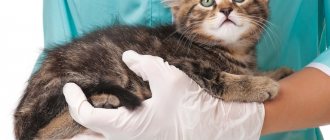Feline mycoplasmosis is caused by protozoan microorganisms: M. Gateae, M. Felis and M. Feliminutum. A disease of a contagious nature that affects body systems. For example, bilateral conjunctivitis may develop, which affects the 3rd eyelid; disturbances in the respiratory, genitourinary and musculoskeletal functions are also detected.
The disease rarely begins on its own . More often it occurs against the background of another pathology or with a severe decrease in the animal’s immunity. A cat can get sick at any age. If treated incorrectly or untimely, the disease can cause serious complications in the body. Mycoplasmosis also becomes chronic. The disease can cause pneumonia or lead to pulmonary edema.
Important! The pathology is sometimes asymptomatic.
Source of infection
Mycoplasmas are found everywhere: in soil, in water, on plants, household items, it can even be carried on clothes and shoes. But the pathogen is unstable in the external environment and quickly dies.
The incubation period lasts up to 10 days. At this time, the infectious agent spreads throughout the body, as well as to other cats.
The danger is greater for small kittens and cats under 2 years of age.
A pet can only get sick through contact with a sick animal or a carrier of the infection. During childbirth, there is a risk of transmission of mycoplasmas to kittens, and intrauterine infection is possible. An animal can also become infected through items caring for a sick cat: toys, bedding, a bowl and all the things that the unhealthy animal touched.
Penetrating into the body, the pathogen passes into the cellular structures of the mucous membranes, conjunctiva, respiratory and genitourinary systems. They can also live in joints. Living in the animal’s body, the microorganism secretes endotoxin, which causes various disorders in the body.
M.Gatae rarely causes any serious problems in the body. This type of pathogen is found in the mucous membrane of the upper respiratory tract. With the development of pathology, in the case of low immunity or due to another pathology, there may be conjunctivitis, pneumonia, diseases of the genitourinary system. Rarely, abortions and polyarthritis of a fibropurulent nature.
M. Felis poses a great danger to the cat's health. Here you can already see the full clinical picture of the disease.
Important! Mycoplasmas, while in the body, secrete special substances. They allow the pathology to occur unnoticed by the pet’s immune system.
Signs of the disease
Feline mycoplasmosis has the following symptoms:
- Redness of the eyeball;
- Cough;
- The kitten has a fever;
- Runny nose;
- Pain in the hypochondrium;
- Diarrhea;
- Joint pain;
- Puffiness of the eyes, the third eyelid is visible;
- In kittens, conjunctivitis most often occurs in the eye, and in rare cases, in both.
Symptoms of mycoplasmosis in young animals appear weaker than in an adult animal; therefore, if you do not pay attention to vague signs, you may not begin treatment in a timely manner.
Consequences
If the owner does not pay attention to the first symptoms, does not contact a veterinarian to get tested to identify the infection and begin treatment, then irreversible consequences may occur that are dangerous not only to the health, but also to the life of the kitten. Feline mycoplasmosis can lead to:
- Abscesses of the skin;
- Inflammatory diseases of the genitourinary system;
- Conjunctivitis;
- Pneumonia;
- Miscarriages in pregnant cats;
- Inflammation of the joints;
- Secondary infections.
Symptoms of mycoplasmosis
If the disease does not manifest itself in any way, then the owner should be wary of the following signs:
- lethargy;
- drowsiness;
- loss of appetite;
- apathy.
Clinical picture:
- lethargy;
- cough and sneezing;
- rhinitis;
- discharge from the nose and eyes, serous or catarrhal;
- increasing intoxication of the body;
- swelling and redness of the conjunctiva;
- enlarged lymph nodes;
- cystitis;
- vomit;
- diarrhea;
- constipation;
- difficulty urinating or spontaneous urination.
- miscarriage or stillbirth;
- swelling of the joints;
- increase in body temperature.
Important! An advanced form of the disease and lack of proper treatment can lead to the death of the pet.
The chronic form does not occur as clearly as the acute one. With a relapse of chronic mycoplasmosis, mild lacrimation and runny nose are observed. Therefore, if your cat periodically “gets a cold,” you should go to the veterinary clinic and be examined for the presence of mycoplasmas in the pet’s body.
The disease can cause infertility or the birth of stillborn kittens. If they remain alive during childbirth, they will be infected with mycoplasmosis and may have multiple pathologies.
How to understand that your pet has become infected with mycoplasma
The disease has a long incubation period. Owners of infected animals may not realize for several weeks that their pet has health problems. Diagnosis is complicated by the fact that in some cases mycoplasmosis is asymptomatic.
The clinical picture of the pathology is vague and depends on the location of the parasites, the immune status of the cat and its age. Symptoms can vary and occur with varying degrees of intensity and severity. In the early stages, the disease may resemble a common cold.
General symptoms of mycoplasmosis in cats
- Anemia.
- Lethargy, apathy, drowsiness.
- Decreased appetite, anorexia.
- Decreased physical activity, weakness.
- Increased body temperature, fever.
- Jaundiced skin color.
- Paleness of the skin and mucous membranes.
- Changes in behavior, depression.
- Tearing.
- Purulent and serous discharge from the eyes and nose.
Signs depending on the location of the parasites
- Rhinitis, sneezing, dry cough.
- Difficulty breathing, shortness of breath.
- Swelling and pain in the joints. Arthritis.
- Gait disturbance, problems with movement.
- Infectious diseases of the urinary tract. Cystitis.
- Prostatitis.
- Involuntary urination.
- Pneumonia, bronchitis.
- Conjunctivitis.
- Enlarged lymph nodes and spleen.
- Purulent inflammation, ulcers and erosions on the skin.
- Reproductive problems: spontaneous abortion, infertility, stillbirth.
If any of these signs appear, you must immediately take your pet to a veterinarian to make a diagnosis and prescribe a treatment regimen.
Complications
With timely and correct treatment, consequences can be avoided. If the cat is very sick or the pathology occurs against the background of an intense decrease in immunity, complications may develop:
- heart disease: arrhythmia or tachycardia, pericarditis;
- arthritis or arthrosis;
- hepatitis or hepatosis;
- renal failure, nephrosclerosis.
Diagnosis and treatment
The diagnosis of mycoplasmosis is made in a complex manner: anamnesis is collected, examination data of the animal, and biological fluids are analyzed, for example, rinsing from the conjunctiva or discharge from the genitals. In order to differentiate the pathology from others with similar symptoms, ELISA and PCR studies are carried out. Blood is also collected for biochemical analysis.
For successful treatment of pathology, it is important to follow its scheme:
- Antibiotic therapy. The duration depends on the drug chosen and the condition of the cat. Mostly from 7 to 14 days. Tetracycline antibiotics are used here.
- Symptomatic therapy. If the eyes or nasal passages are affected, use special drops and rinse the mucous membranes with saline solutions. Treat until symptoms resolve.
- Immunomodulatory therapy. For weakened animals. Course up to 5 days.
- Maintenance therapy. Since the cat is taking antibiotics, you need to take care of the condition of the liver. Therefore, means are prescribed to support its functions. It is also worth considering that during therapy with antimicrobial drugs, the intestinal microflora suffers. Medicines are prescribed that contain beneficial bacteria for the gastrointestinal tract. The treatment time is the same as the course of antibiotics.
Treatment can take place at home. Only after consulting a veterinarian and carefully following all recommendations. Cats that are in serious condition are subject to hospitalization.
When prescribing treatment, concomitant diseases must also be taken into account . For example, if your pet has liver damage, you should tell your veterinarian.
Before starting treatment, it is recommended to do an antibiotic sensitivity test.
In the acute form of the disease, symptoms can be eliminated in 3-4 days. In the chronic form, recovery may take several months. After completing the course of treatment, it is important to consult a veterinarian. This is necessary to conduct research on the presence of the pathogen in the body.
How to treat mycoplasmosis in cats
Mycoplasmosis requires competent and long-term treatment.
Therapy for such a disease is very long-term, as it is aimed at eliminating a large number of lesions of various organs.
There is no vaccination against mycoplasmosis and the only way to prevent the disease is to pay attention to your pet. The presence of the pathogen M. felis requires immediate medical intervention. The type of these microorganisms necessarily creates a pathogenic environment in the body and provokes various diseases, so treatment should be started immediately.
Medicines
- It is recommended to prescribe antibiotic therapy in the form of drugs from the tetracycline group.
- In parallel, immune agents are used, since stable immunity is the key to the effectiveness of treatment. Recommended substances: azithromecin, enrofloxacin, ofloxacin. Even the slightest deviation from the treatment regimen prescribed by the doctor is unacceptable.
Veterinarians prescribe azithromycin to maintain the pet's immunity.
Karsil is a good medicine for maintaining a cat's liver.
The drug "Feliferon" enjoys good recommendations.
Caring for a cat when sick
If a pet lives in an apartment alone, without other cats, then it should not be isolated in a separate place. It is enough to organize a convenient and comfortable lounger for him. Provide him with fresh drink and food that will not unduly burden the gastrointestinal tract and liver. Include more vitamins and minerals in your animal's diet.
Important! To avoid causing unnecessary suffering to your pet, it should not be picked up. This is due to the fact that pathology also develops in the joints and can cause pain to the cat.
Recovery from infection depends on many factors. First of all, this is a correct diagnosis, which can only be made by a veterinarian. Next, you must follow all his instructions and treatment regimen. You need to give antibiotics as much as the specialist recommends, and not stop taking them when the symptoms have subsided.
Recovery also depends on the animal’s immunity. The higher it is, the faster the pet will recover. Therefore, it is necessary to help increase the body’s resistance with the right diet and immunomodulators.
Prevention
It should be remembered that mycoplasmosis often occurs due to other diseases. Therefore, it is worth taking care of timely vaccination of the animal. You should also monitor your pet’s immunity and periodically take a course of vitamins and minerals.
It is worth limiting contact with other cats, especially with those who have previously suffered from any diseases or suffer from mycoplasmosis. You need to try to create comfortable living conditions for your pet. Organize proper nutrition so that it covers the body's need for microelements.
It is necessary to take care of the temperature at home, since the cat may catch a cold and, against the background of decreased immunity, it may develop mycoplasmosis. The place where the animal lives must be clean and promptly cleaned, and the tray must always be clean. Do not forget
To prevent your animal from getting sick, it is important not to expose it to stress. Create a comfortable atmosphere at home. Do not scream or hit the animal.
Danger to humans
Although people suffer from mycoplasmosis, it is impossible to get it from a pet. The species that can affect cats are not dangerous to humans. However, if your cat is sick, you should not neglect personal hygiene measures and wash your hands thoroughly after interacting with the animal. You should also reduce contact between sick people and children.
In extremely rare cases, mycoplasma from a cat is found in a person with a suppressed immune system.
If you have several cats living in your home, you should quarantine the sick animal. There is no need to worry if you have other pets (dogs, rabbits, parrots, etc.), since feline mycoplasmosis pathogens are not transmitted to them.
Causes of mycoplasmosis, risk group
At risk of contracting mycoplasmosis are:
- kittens under 2 years of age;
- animals with reduced immunity;
- cats with chronic pathologies.
Since the causative agent of this disease cannot exist for a long time outside a living organism, it is almost impossible to become infected with it while drinking water or eating food.
Therefore, it is believed that the only way of transmitting the infection is direct contact with an infected animal.
Penetration of microorganisms into the body of a healthy cat can occur through blood transfusion, contact with open wounds or cuts, during sexual intercourse, or during delivery (from mother to kitten).
Useful video
Veterinarian about mycoplasmosis in cats:
To limit your pet from mycoplasmosis, it is important to surround it with care and attention. Don't ignore vaccinations. Remember that pathology occurs due to reduced immunity and other diseases, so provide it with nutrition that would cover the needs for vitamins and minerals. Create conditions so that the animal has less contact with street cats or sick ones.
If even minor clinical signs are detected, seek help immediately. During treatment, it is important to strictly follow all doctor’s recommendations. And then your animal will be healthy and happy.
Main causes
Mycoplasma is a single-celled anaerobic microorganism that is not a virus or bacteria. In nature, there are 6 varieties of the pathogen, but mycoplasmosis in cats is caused by M. felis, M. gateae and M. Feliminutum. Mycoplasma infections easily spread from a sick cat to a healthy one, so the disease is contagious. Often the disease occurs against the background of other pathologies of an infectious nature, such as chlamydia, herpes and other disorders. Mycoplasmosis is dangerous for animals with weakened immune systems - kittens, pregnant cats, elderly pets.
The disease is transmitted in the following ways:
- airborne;
- contact;
- sexual;
- during childbirth.











